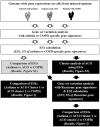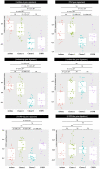Transcriptome analysis of sputum cells reveals two distinct molecular phenotypes of "asthma and chronic obstructive pulmonary disease overlap" in the elderly
- PMID: 36307832
- PMCID: PMC9617312
- DOI: 10.1186/s40001-022-00861-2
Transcriptome analysis of sputum cells reveals two distinct molecular phenotypes of "asthma and chronic obstructive pulmonary disease overlap" in the elderly
Abstract
Background: Little is known about the pathogenesis of asthma and chronic obstructive pulmonary disease (COPD) overlap (ACO). This study examined the molecular phenotypes of ACO in the elderly.
Methods: A genome-wide investigation of gene expression in sputum cells from the elderly with asthma, ACO, or COPD was performed using gene set variation analysis (GSVA) with predefined asthma- or COPD-specific gene signatures. We then performed a subsequent cluster analysis using enrichment scores (ESs) to identify molecular clusters in the elderly with ACO. Finally, a second GSVA was conducted with curated gene signatures to gain insight into the pathogenesis of ACO associated with the identified molecular clusters.
Results: Seventy elderly individuals were enrolled (17 with asthma, 41 with ACO, and 12 with COPD). Two distinct molecular clusters of ACO were identified. Clinically, ACO cluster 1 (N = 23) was characterized by male and smoker dominance, more obstructive lung function, and higher proportions of both neutrophil and eosinophil in induced sputum compared to ACO cluster 2 (N = 18). ACO cluster 1 had molecular features similar to both asthma and COPD, with mitochondria and peroxisome dysfunction as important mechanisms in the pathogenesis of these diseases. The molecular features of ACO cluster 2 differed from those of asthma and COPD, with enhanced innate immune reactions to microorganisms identified as being important in the pathogenesis of this form of ACO.
Conclusion: Recognition of the unique biological pathways associated with the two distinct molecular phenotypes of ACO will deepen our understanding of ACO in the elderly.
Keywords: Asthma; Asthma-chronic obstructive pulmonary disease overlap syndrome; Chronic obstructive pulmonary disease; Cluster analysis; Sputum; Transcriptome.
© 2022. The Author(s).
Conflict of interest statement
The authors declare that they have no competing interests.
Figures



Similar articles
-
Distinct physiological, transcriptomic, and imaging characteristics of asthma-COPD overlap compared to asthma and COPD in smokers.EBioMedicine. 2024 Dec;110:105453. doi: 10.1016/j.ebiom.2024.105453. Epub 2024 Nov 23. EBioMedicine. 2024. PMID: 39580967 Free PMC article.
-
[Correlation between expressions of myeloperoxidase and eosinophil cationic protein in sputum and clinical features of asthma-chronic obstructive pulmonary disease overlap].Nan Fang Yi Ke Da Xue Xue Bao. 2018 Sep 30;38(10):1215-1221. doi: 10.3969/j.issn.1673-4254.2018.10.10. Nan Fang Yi Ke Da Xue Xue Bao. 2018. PMID: 30377121 Free PMC article. Chinese.
-
Mucus plugging on computed tomography and the sputum microbiome in patients with asthma, chronic obstructive pulmonary disease, and asthma-COPD overlap.Allergol Int. 2024 Oct;73(4):515-523. doi: 10.1016/j.alit.2024.05.004. Epub 2024 Jul 16. Allergol Int. 2024. PMID: 39013753
-
Current Knowledge of Asthma-COPD Overlap (ACO) Genetic Risk Factors, Characteristics, and Prognosis.COPD. 2021 Oct;18(5):585-595. doi: 10.1080/15412555.2021.1980870. Epub 2021 Sep 24. COPD. 2021. PMID: 34555990 Review.
-
Asthma and COPD overlap pathophysiology of ACO.Allergol Int. 2018 Apr;67(2):179-186. doi: 10.1016/j.alit.2018.01.001. Epub 2018 Mar 15. Allergol Int. 2018. PMID: 29550368 Review.
Cited by
-
Severity of Lung Function Impairment Drives Transcriptional Phenotypes of COPD and Relates to Immune and Metabolic Processes.Int J Chron Obstruct Pulmon Dis. 2023 Mar 14;18:273-287. doi: 10.2147/COPD.S388297. eCollection 2023. Int J Chron Obstruct Pulmon Dis. 2023. PMID: 36942279 Free PMC article.
References
-
- McDonald VM, Higgins I, Gibson PG. Managing older patients with coexistent asthma and chronic obstructive pulmonary disease: diagnostic and therapeutic challenges. Drugs Aging. 2013;30(1):1–17. - PubMed
-
- Lefaudeux D, et al. U-BIOPRED clinical adult asthma clusters linked to a subset of sputum omics. J Allergy Clin Immunol. 2017;139(6):1797–1807. - PubMed
-
- Singh D, et al. Induced sputum genes associated with spirometric and radiological disease severity in COPD ex-smokers. Thorax. 2011;66(6):489–495. - PubMed
MeSH terms
LinkOut - more resources
Full Text Sources
Medical

